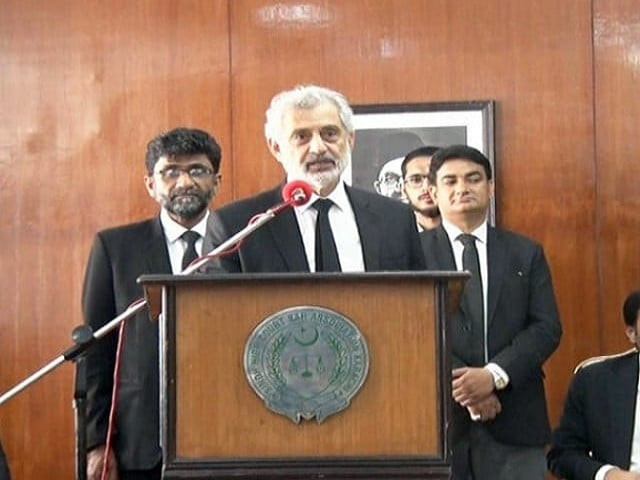CJ ‘unaware’ of any new meddling incident
says issues highlighted by IHC judges occurred before his tenure as chief justice

While reaffirming that state interference in judicial matters is unacceptable, the country’s top judge, Justice Qazi Faez Isa, said that no incident of meddling in the affairs of any court has been reported since he assumed the role of chief justice of Pakistan.
“The incidents of meddling in the affairs of the Islamabad High Court (IHC) occurred before I assumed the role of the CJP,” Justice Isa addressed a function organized by the Sindh High Court Bar Association (SHCBA) in Karachi on Thursday.
“Any interference [of state institutions] in courts is unacceptable,” he added.
Last month, on October 25, six of the eight IHC judges wrote a letter to the Supreme Judicial Council (SJC) chairman, Justice Isa, accusing the country’s spy agencies of employing coercive tactics to pressure justices of the capital’s high and lower courts.
The letter cited various incidents ranging from the abduction and torture of certain judges' family members to the installation of secret cameras and recording devices inside a justice’s house, allegedly by operatives of intelligence agencies.
According to the letter, the IHC judges had brought these incidents to the attention of former Chief Justice of Pakistan Umar Ata Bandial and IHC Chief Justice Aamer Farooq in May 2023. However, the “interference on the part of intelligence operatives” persisted even after assurances from the IHC CJ.
Justice Isa noted that since his elevation as the CJP in September 2023, no judge of any high court had lodged any complaint about the alleged meddling of state institutions in court matters. “Even if any incident of meddling has occurred, it has not been reported,” he added.
The SC took suo motu notice of the IHC judge’s letter on April 2 after the government’s attempt to form an inquiry commission failed. Currently, a bench led by Justice Isa is hearing the case.
On April 23, all judges of the IHC unanimously acknowledged that intelligence agencies were “interfering” in their judicial functions in a full court meeting, chaired by Chief Justice Aamer Farooq.
The meeting was held in view of the Supreme Court's order seeking proposals from high courts on how to protect the independence of the judiciary from the “interference” of agencies. Earlier, the Lahore and Peshawar high courts had also convened full court meetings to discuss the matter.
The speech
The CJ, who is currently in Karachi to hear various cases at the SC’s registry in the megacity, emphasized the need to preserve the historic building of the Sindh High Court in its original condition.
Construction of the existing building of the SHC began in 1923 during the British Raj at an estimated cost of Rs39,75,248. It was completed on November 22, 1929, at a cost of Rs30,35,000.
This building which was meant for 5 judges with some provision for expansion is now accommodating benches, courtrooms, and 18 judges in chambers. Some judges have to hold courts in chambers.
Justice Isa remarked, “There are many historical buildings in Karachi. If someone wants to see old buildings, they should visit the Parsi Colony. My recommendation is not to give these buildings to builders." The CJ thanked the SHC Chief Justice and the SHCBA.
He mentioned that this was his first visit to the SHC’s barroom.
“I used to come to the court with my father, but this barroom was not built then. We used to come to Karachi during the summer vacations, which lasted for three months. My memories are associated with the Sindh High Court," he said,
Regarding the construction of a new building for the Supreme Court’s Karachi Registry, he stated that construction was estimated to cost between Rs7 to Rs8 billion.
“Now, 36 federal courts and tribunals will be built on this site. It is hoped that this will be the first federal court building,” he said.
He emphasized that the SC’s existing building in Karachi holds historical significance and is a cultural heritage that should be preserved like all other historical buildings in the city.



















COMMENTS
Comments are moderated and generally will be posted if they are on-topic and not abusive.
For more information, please see our Comments FAQ